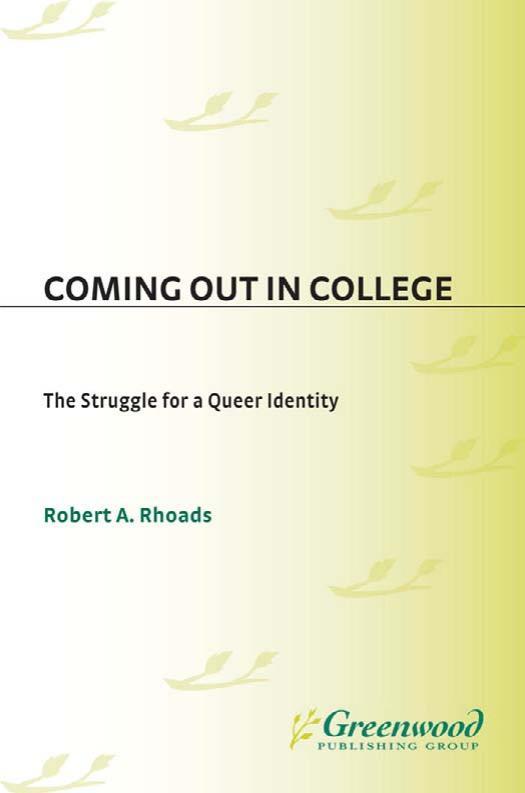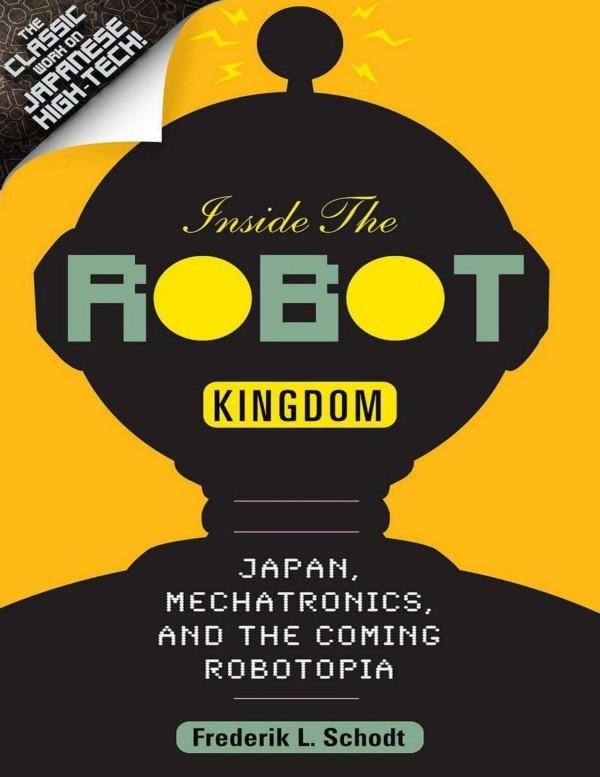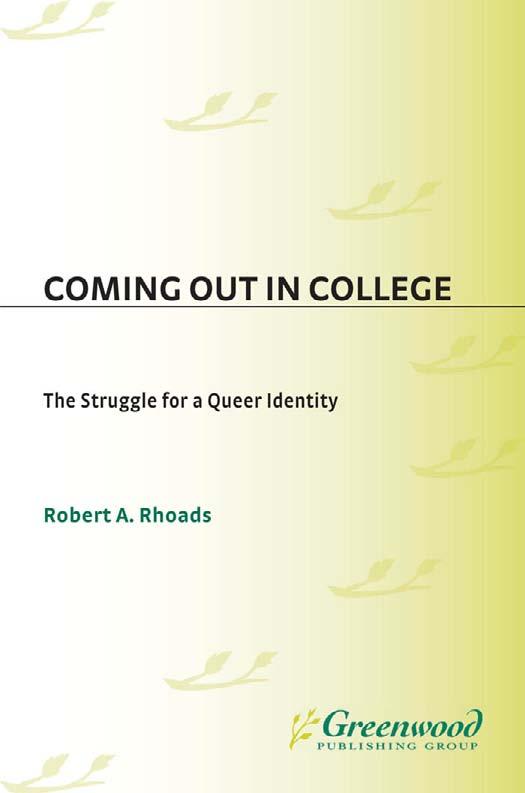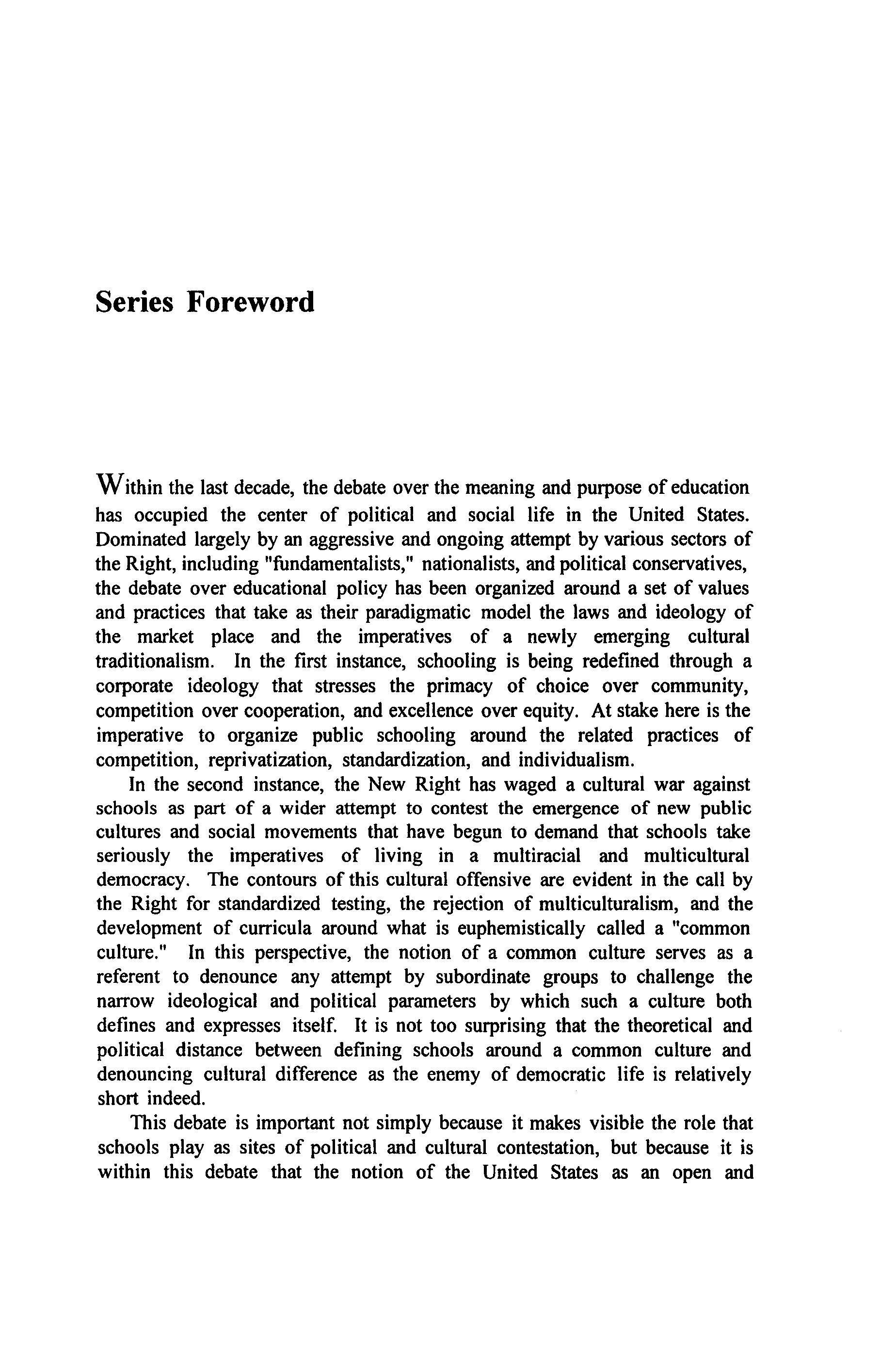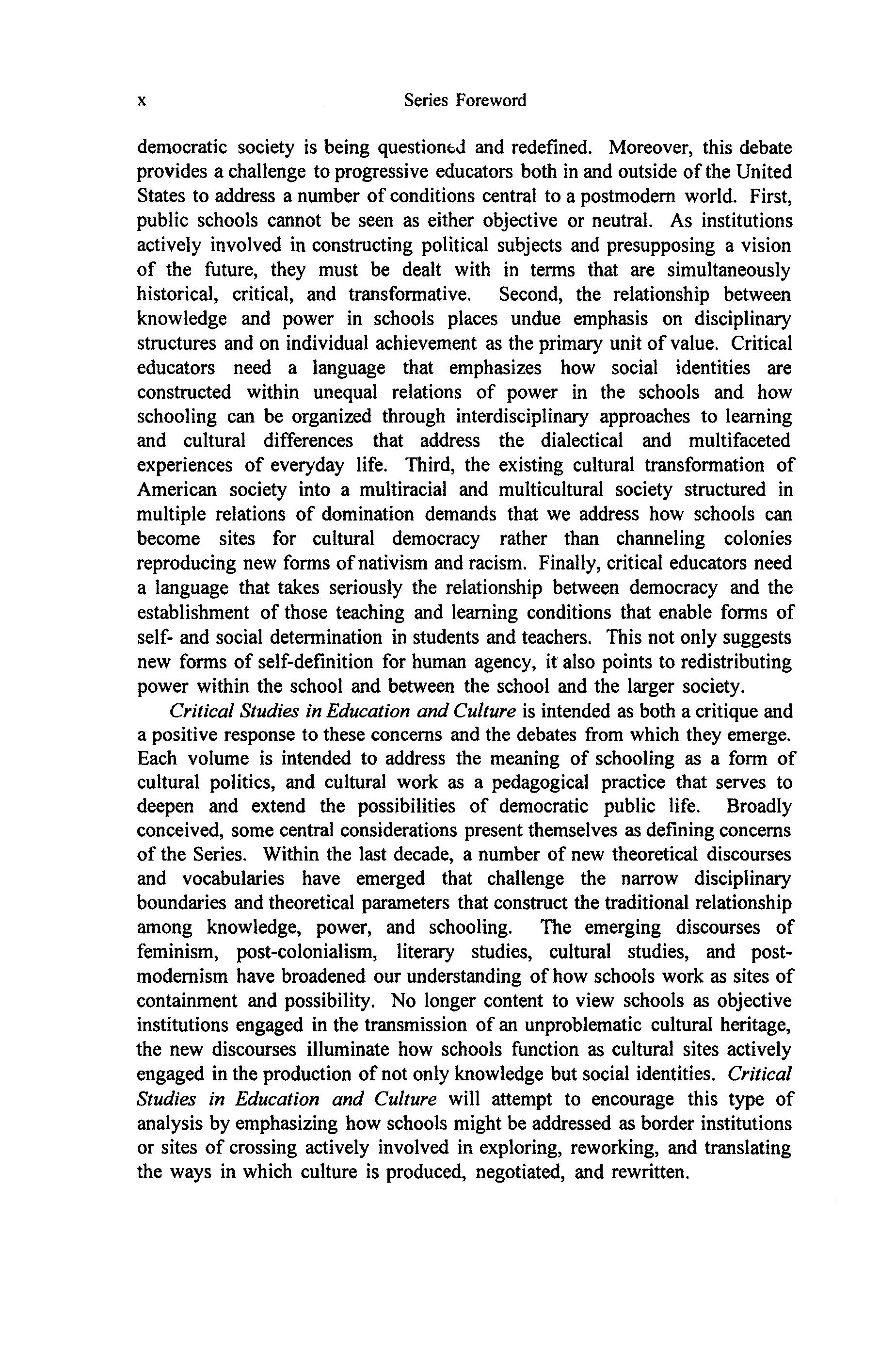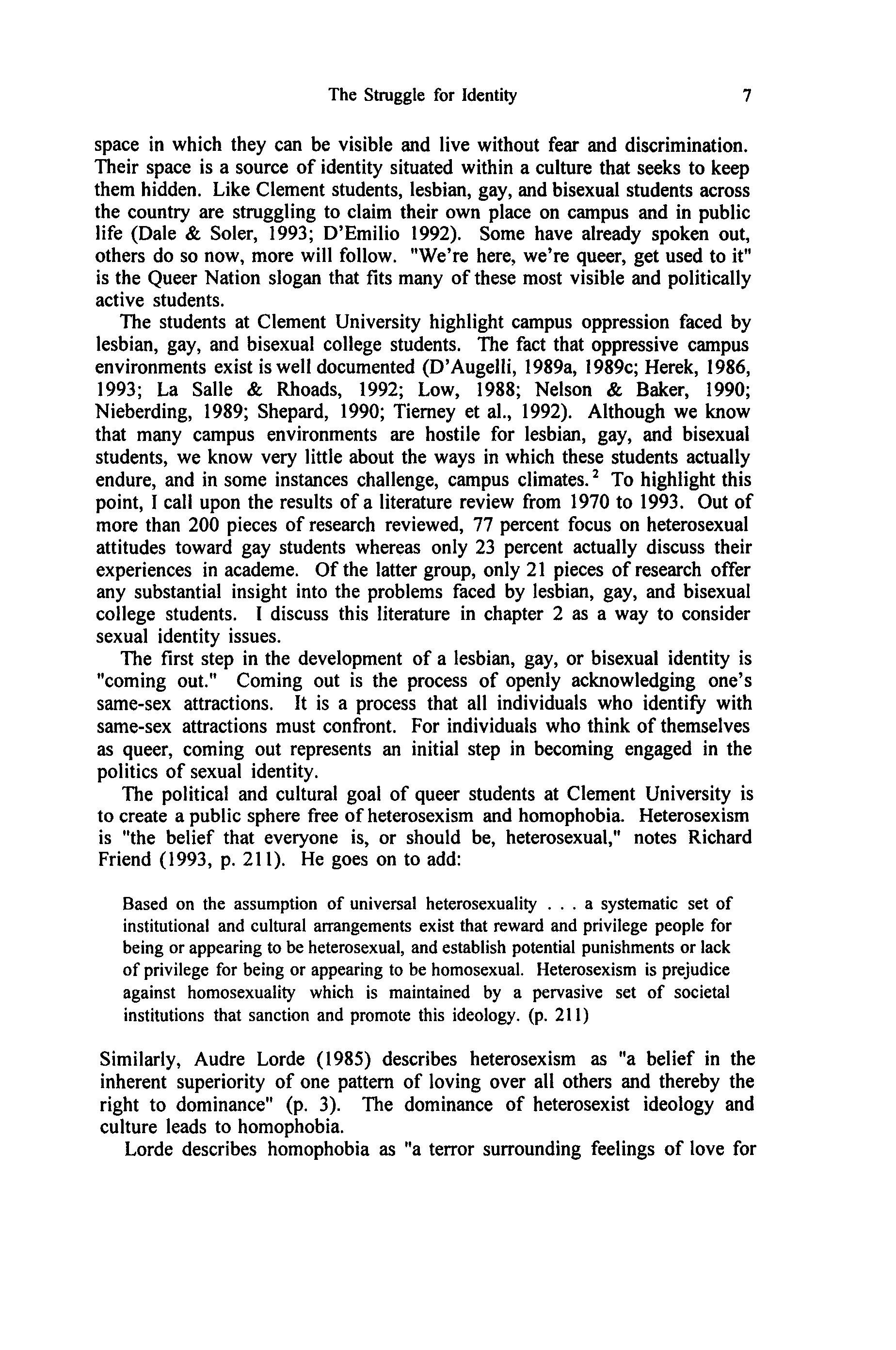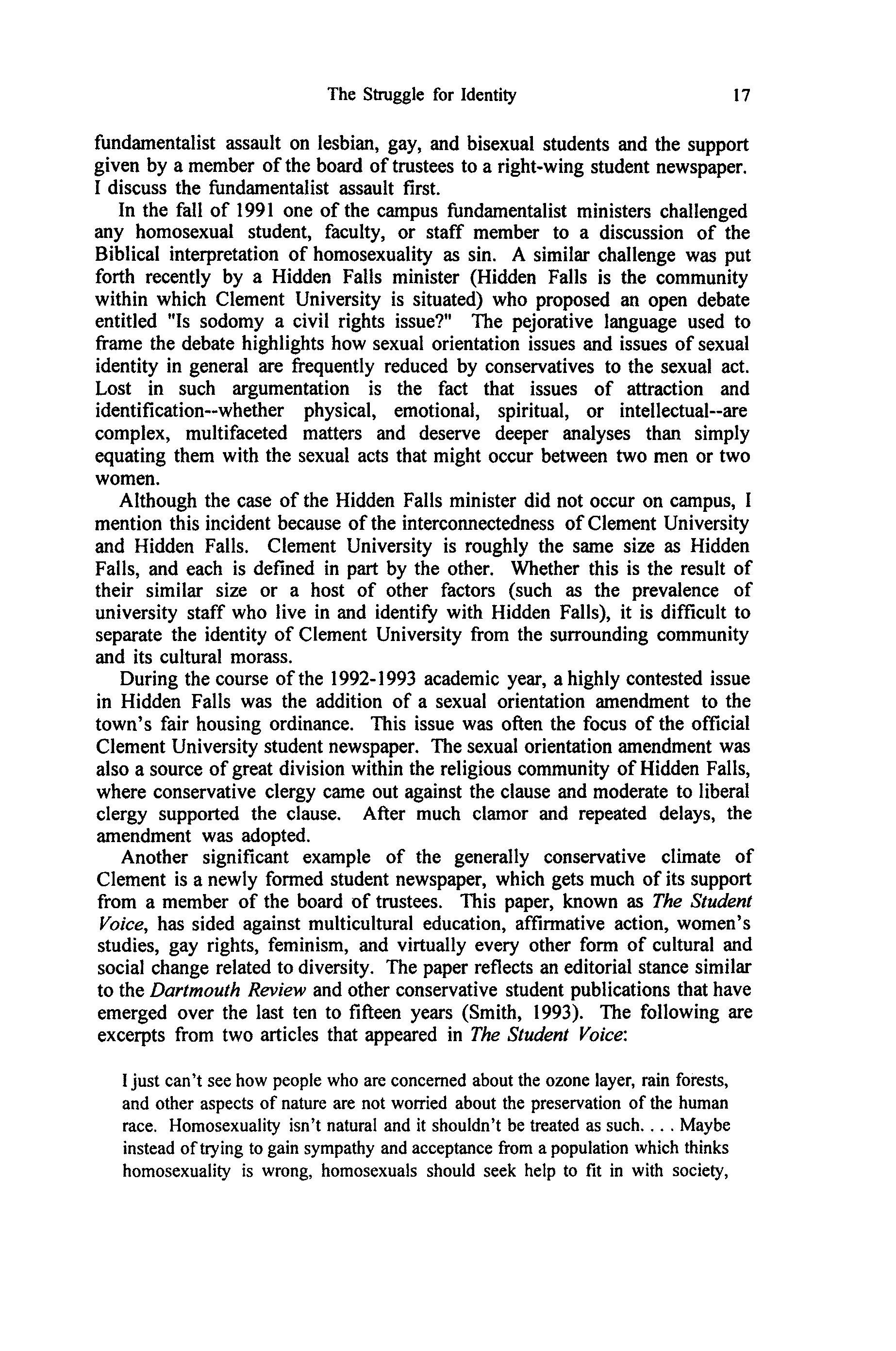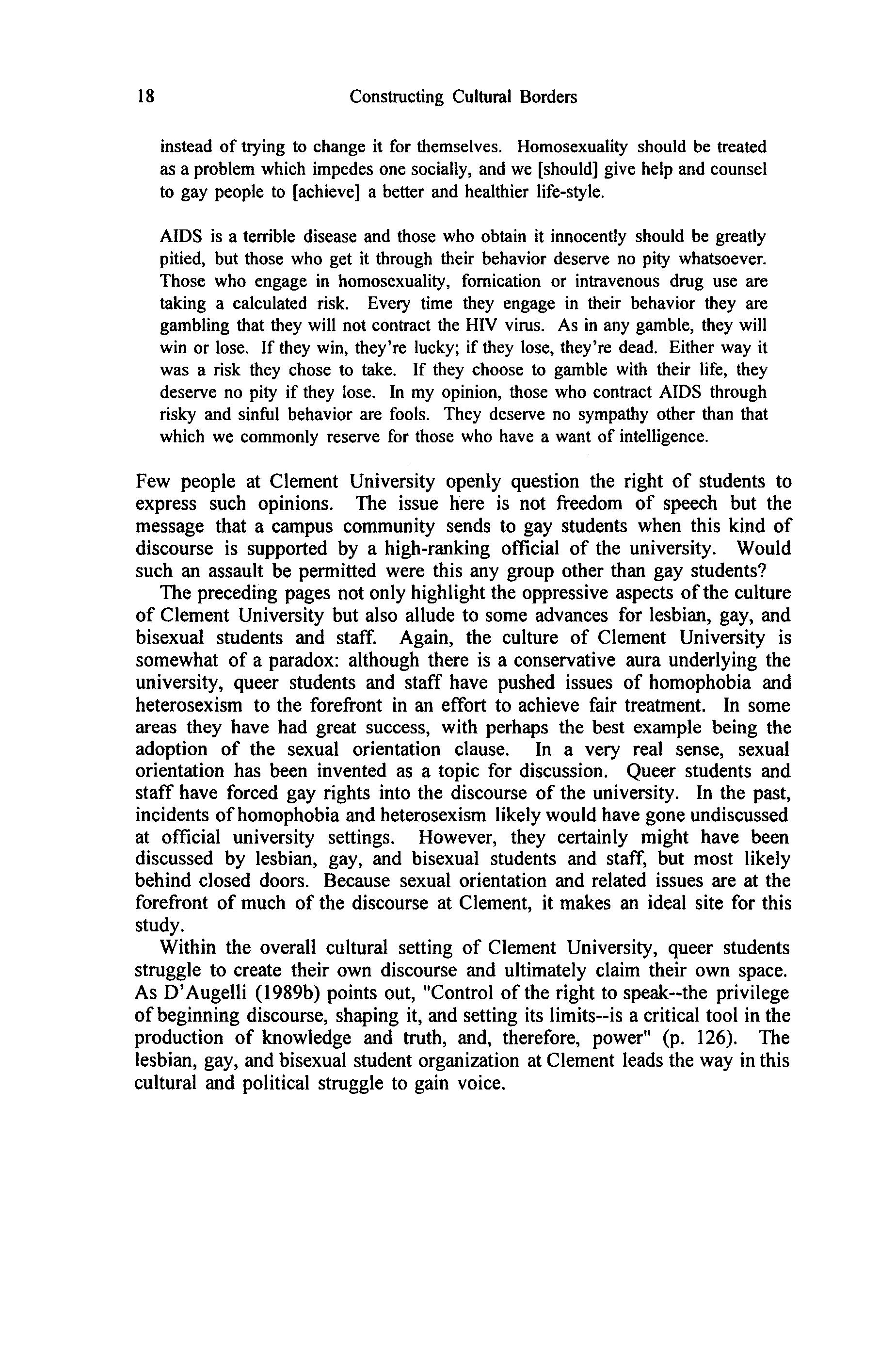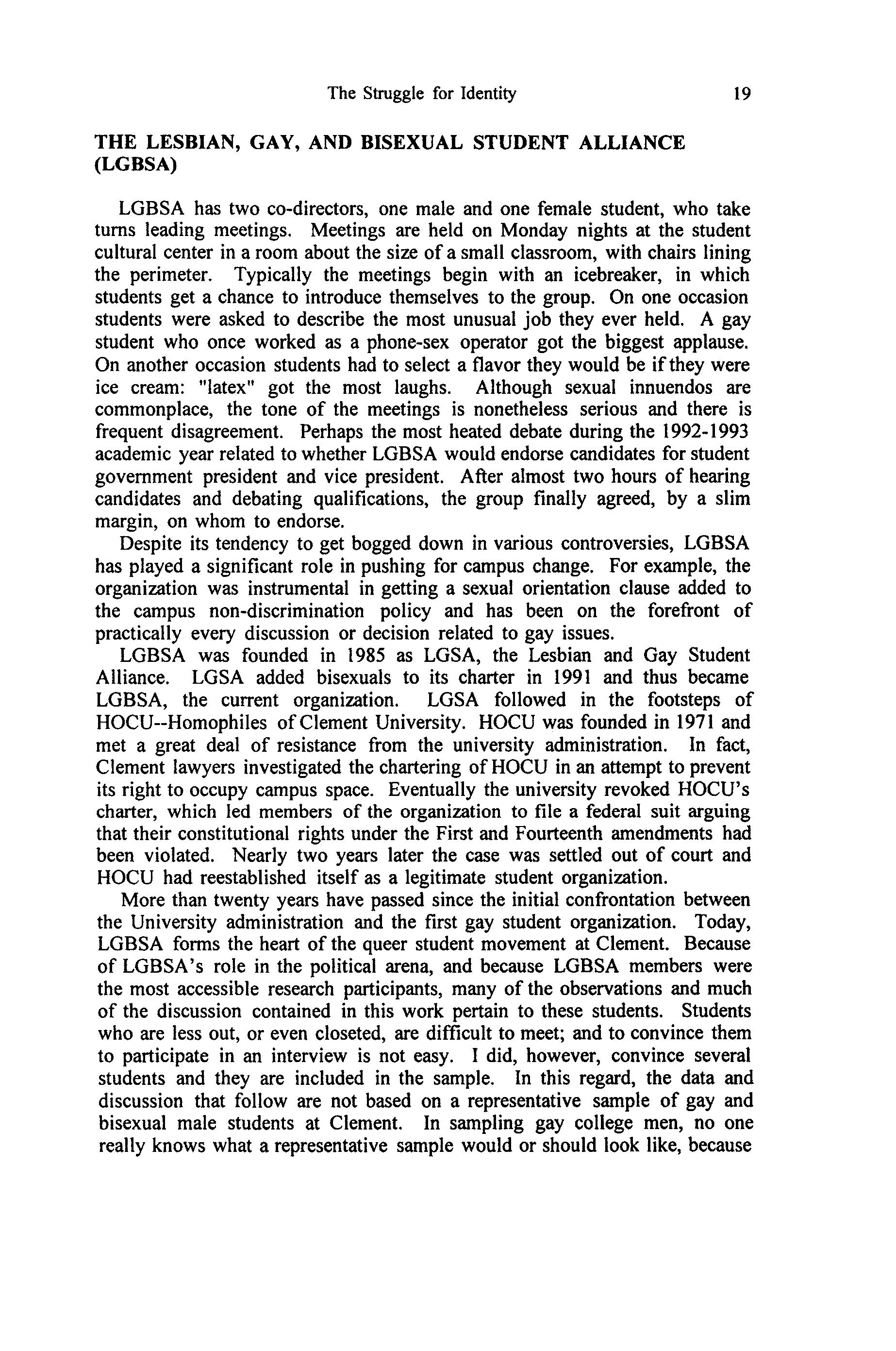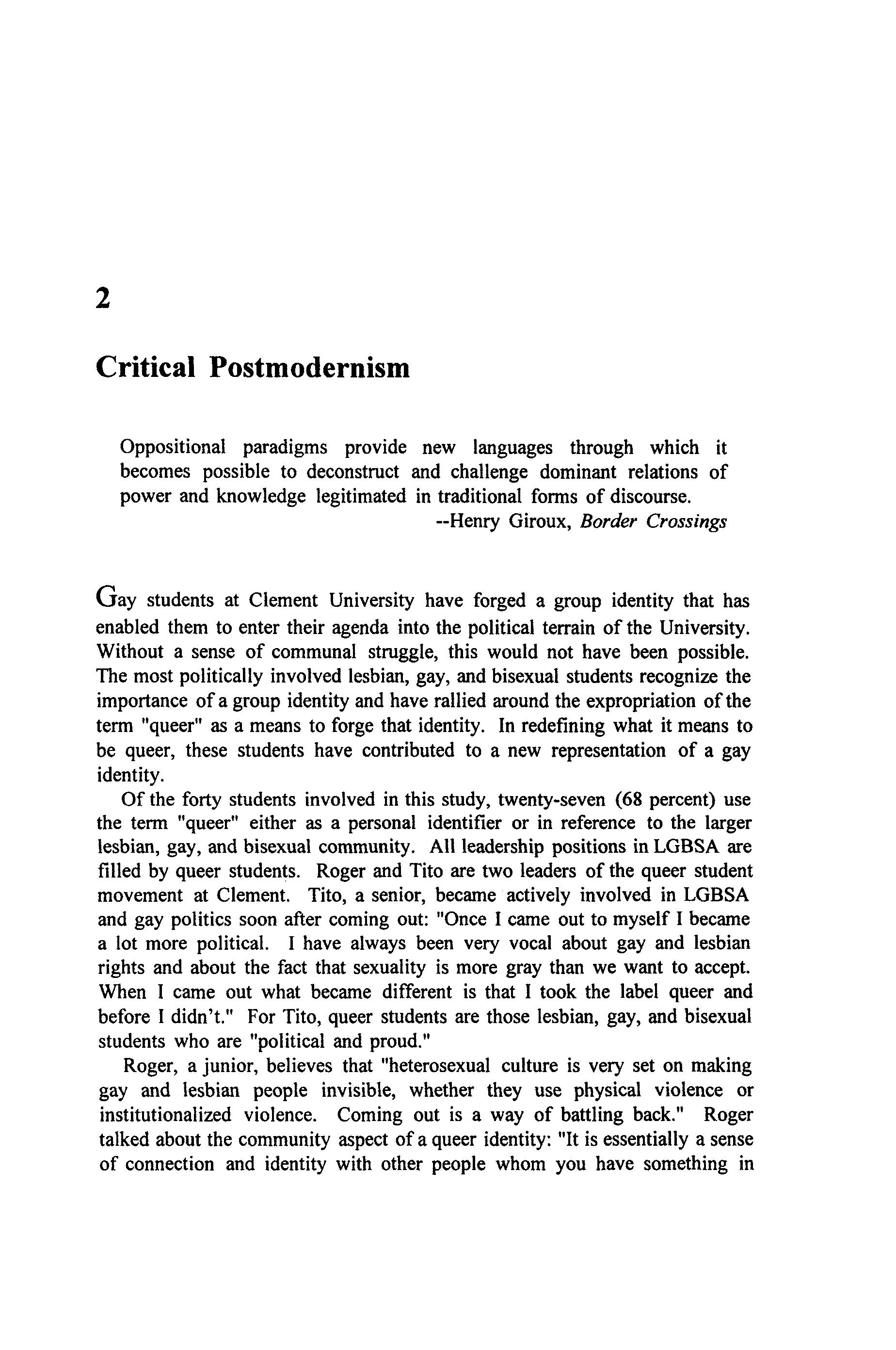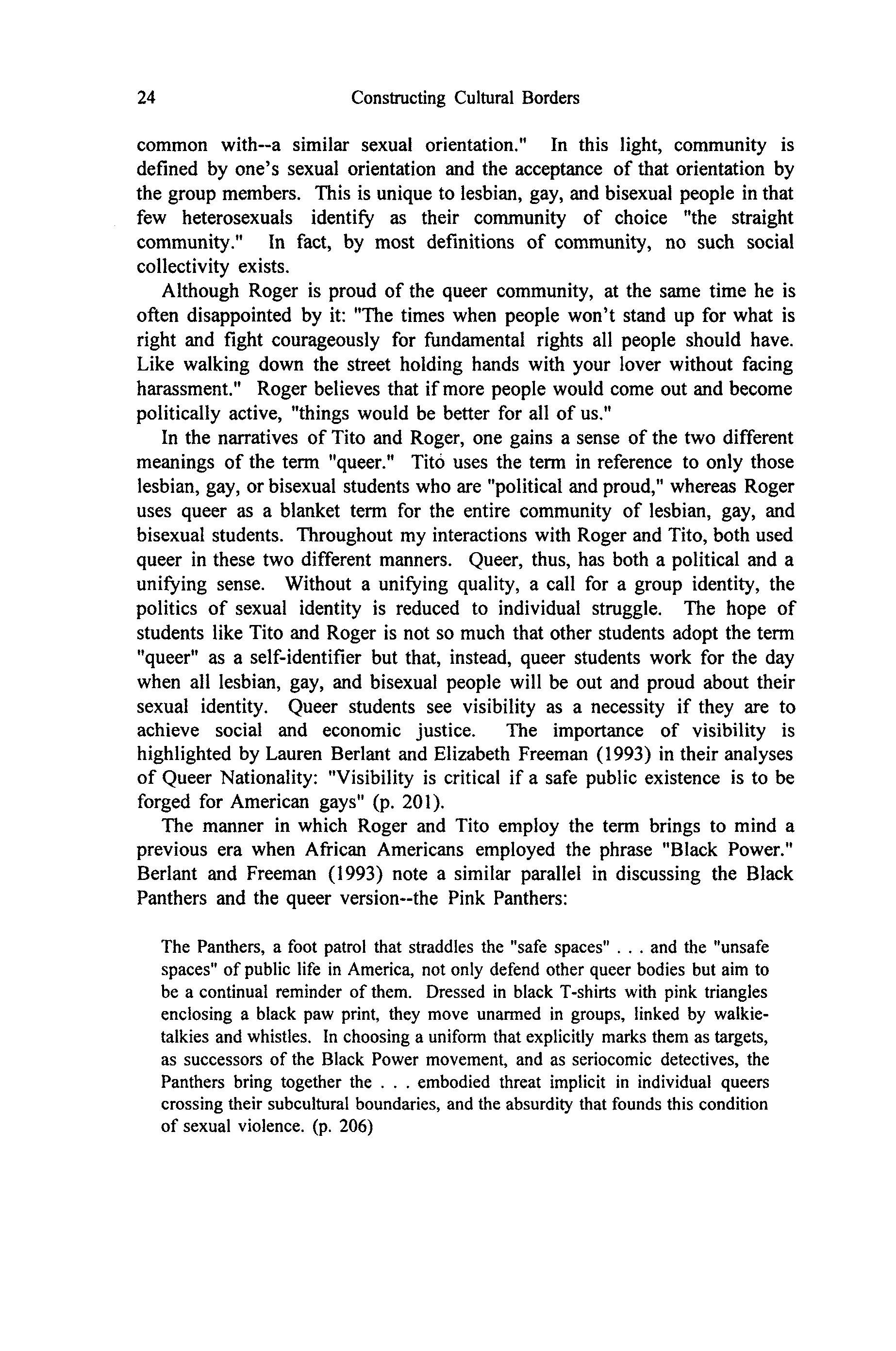The Struggle for Identity
Gay men and lesbians are orphans and our community is a collection of orphans. .. . We are like strangers who have been dropped on an island together.
-Brian
McNaught, On Being Gay
A fog-like drizzle steadily fell upon a crowd of pink and lavender. The temperature was in the low 40s, but a cold north wind made the October day seem almost wintry. It was certainly no day to be standing outside for any length of time. Despite the cold and dampness, some thirty or so students had gathered on the steps of the auditorium on the campus of Clement University1 for a local celebration of National Coming Out Day. Another 200 students stood on the adjacent sidewalk; they were there to offer support or to venture out of their closets in their own way. Shane, a handsome junior who majors in engineering, commented after the rally: "It was so exciting just to be in the crowd. The whole rally was very emotional, even just standing there watching." On this chilly day in 1992, Shane was content to be a silent voice, listening and offering support to others as they talked about what it was like to be queer and proud.
The term "queer" is an identifier adopted by a majority of the gay students who will be heard throughout this work. For these students, identifying as queer connotes a sense of pride and openness about one's same-sex desires as well as a degree of hostility toward heterosexism. Among other characteristics, being queer involves a certain attitude about one's sexual identity. This attitude was expressed by Shane some nine months after participating in National Coming Out Day: "Sometimes I feel like being very out and telling people who have a problem with it to piss off!" As another student explained, "To be queer is to be open about your sexual orientation. It means not being ashamed in any way." These students offer one

Next, a gay student took his turn at the podium. He told a story of having been beaten up over the summer by a couple of students and showed the subsequent scar left on his forehead. His attackers did not appreciate his flamboyant mannerisms. "I'm a queen and I'm not ashamed. I wear this scar as a badge offreedom—freedomthat no one will ever take away from me." Another student stepped through the makeshift door frame erected at the top of the steps. The door frame symbolized the passage from "the closet" to a public identity-from a state of hiding to a state of openness about one's samesex attractions. "I came out to my dad so he would stop asking me about girlfriends. I came out because I'm a gay man. I don't want anyone to accept me-I want them to respect me for who I am." Then Andrew, a tall senior and one of the leaders of the campus queer movement, spoke next:
When I was little I was attracted to boys, not to girls. I lived with this feeling for years, without anyone knowing, without knowing what to do about it. It wasn't until I came to Clement that I realized it was possible to live happily as a gay man. Lesbian, gay, and bisexual people have two choices: come out or stay in your closet and continue hating yourself. Coming out is better than hating yourself. . . . Coming out is more than saying the word. It's about celebrating yourself. I'll never forget the time some fraternity guys beat me up while their gay brothers stood and watched. They chose to remain closeted. Coming out is about standing next to your real brothers.
One by one lesbian, gay, and bisexual students climbed the steps of the auditorium. Steps that must have seemed like years to them. They were all there for the same purpose: they came to publicly announce their sexual identity.
From time to time I heard background noise from across the sidewalk and lawn separating the auditorium from the campus's main classroom building. The classroom building had been the hub of student activity at Clement University for years, mostly because of its central location. This was the site where the "Clement Preacher" regularly proclaimed his conservative Christian views in an attempt to convert students. Although the Clement Preacher was often criticized by other Christians, even by some campus fundamentalists who saw his methods as more alienating than "discipling," he nonetheless seemed to galvanize conservative opposition to gay rights. While some 200 students stood around the steps of the auditorium in support of the lesbian, gay, and bisexual students, a similar-sized crowd formed around the Clement Preacher. The crowd at the classroom building was boisterous, and I struggled to maintain my focus on the steps of the auditorium. No sooner had I regained my concentration than another round of uproarious laughter arose from the Clement Preacher's crowd. He was on a roll: "So a guy puts his penis in another guy's butt" was all I could make out; the laughter from his surrounding audience was too loud. And now people around me were laughing; something humorous had occurred on the steps of the auditorium. Then the Preacher had his crowd going again. Their laughter was louder than

before. Back and forth the two crowds competed.
"What does the Bible say about homosexuals? The Bible says that it is unsightly in the eyes of God. That it is offensive to God. That it is abominable in the eyes of God," yelled the Clement Preacher. He turned and pointed toward the steps of the auditorium: "They would have you believe that it is ok. That Christian morality is archaic. That it doesn't apply to us today. But God's word is eternal. The same yesterday, today, and tomorrow."
His words struck a chord in my own mind. Two or three years earlier, I held similar views about homosexuality. I had tossed around the very issue he was now raising. Eventually, I came to the same horizon that Toni challenged others to reach: when it comes to the love of other people, there is no such thing as bad love. In the end, my belief in Christ's teachings about justice and love brought me to support gay rights; and later, student narratives about abuse and discrimination brought me to join the struggle myself.
"I kind of hope I get through this without crying," continued one student. "I think there is going to be a lot of finger pointing and I hope no one takes this personally. But I have some things that need to be said." The student paused as if to catch his breath and prepare himself for what was no doubt to be an emotional outpouring. Several seconds passed .. . they seemed like leg irons.
This goes out to the queer community. To those who don't know where they are. I am sick and tired of being good enough to suck your dick but not good enough to know your name. I am sick and tired of being good enough to be your friend at a nightclub on a Sunday evening but not good enough to be your friend anywhere else. I am sick and tired of being beat up and abused while you stand by and do nothing. I am sick and tired of those who are politically out but who forget where they camefromnot so long ago. I am sick and tired of being good enough for you to talk to but not good enough to be a guest in your home. And most of all, I am sick and tired of being sick and tired.
This book is about the experiences students at Clement University face in their personal struggle to come to terms with same-sex attraction and their communal struggle to change both the culture of the institution and, in turn, the general culture of American society. The remaining sections of this chapter provide a context for this work and highlight the theory and methodology employed in the study.
THE STRUGGLE FOR A PUBLIC SPACE
The voices presented thus far were all heard on National Coming Out Day on the campus of Clement University, a university with over 30,000 students. National Coming Out Day at Clement symbolizes the larger societal struggle faced by lesbian, gay, and bisexual people as they strive to create a public
space in which they can be visible and live without fear and discrimination. Their space is a source of identity situated within a culture that seeks to keep them hidden. Like Clement students, lesbian, gay, and bisexual students across the country are struggling to claim their own place on campus and in public life (Dale & Soler, 1993; D'Emilio 1992). Some have already spoken out, others do so now, more will follow. "We're here, we're queer, get used to it" is the Queer Nation slogan that fits many of these most visible and politically active students.
The students at Clement University highlight campus oppression faced by lesbian, gay, and bisexual college students. The fact that oppressive campus environments exist is well documented (D'Augelli, 1989a, 1989c; Herek, 1986, 1993; La Salle & Rhoads, 1992; Low, 1988; Nelson & Baker, 1990; Nieberding, 1989; Shepard, 1990; Tierney et al., 1992). Although we know that many campus environments are hostile for lesbian, gay, and bisexual students, we know very little about the ways in which these students actually endure, and in some instances challenge, campus climates.2 To highlight this point, I call upon the results of a literature review from 1970 to 1993. Out of more than 200 pieces of research reviewed, 77 percent focus on heterosexual attitudes toward gay students whereas only 23 percent actually discuss their experiences in academe. Of the latter group, only 21 pieces of research offer any substantial insight into the problems faced by lesbian, gay, and bisexual college students. I discuss this literature in chapter 2 as a way to consider sexual identity issues.
The first step in the development of a lesbian, gay, or bisexual identity is "coming out." Coming out is the process of openly acknowledging one's same-sex attractions. It is a process that all individuals who identify with same-sex attractions must confront. For individuals who think of themselves as queer, coming out represents an initial step in becoming engaged in the politics of sexual identity.
The political and cultural goal of queer students at Clement University is to create a public sphere free of heterosexism and homophobia. Heterosexism is "the belief that everyone is, or should be, heterosexual," notes Richard Friend (1993, p. 211). He goes on to add:
Based on the assumption of universal heterosexuality .. . a systematic set of institutional and cultural arrangements exist that reward and privilege people for being or appearing to be heterosexual, and establish potential punishments or lack of privilege for being or appearing to be homosexual. Heterosexism is prejudice against homosexuality which is maintained by a pervasive set of societal institutions that sanction and promote this ideology, (p. 211)
Similarly, Audre Lorde (1985) describes heterosexism as "a belief in the inherent superiority of one pattern of loving over all others and thereby the right to dominance" (p. 3). The dominance of heterosexist ideology and culture leads to homophobia.
Lorde describes homophobia as "a terror surrounding feelings of love for
(1981):
Theword inlanguage ishalfsomeone else's. Itbecomes "one's own"only when the speaker populates it with his own intention, his own accent, when he appropriates the word, adapting itto his own semantic andexpressive intention. Prior to this moment of appropriation, the word does not exist in a neutral and impersonal language (it is not, after all, out of adictionary thatthe speaker gets his words!), but rather it exists in other people's mouths, in other people's contexts, serving otherpeople's intentions: itis from therethatone musttakethe word, and make it one's own. . . . Language is notaneutral medium that passes freely and easily into the private property of the speaker's intentions; it is populated~overpopulated-with theintentions ofothers. Expropriating it,forcing it to submit to one's own intentions and accents, is adifficult and complicated process, (pp. 293-294)
Higginbotham concludes: "Blacks took 'race' and empowered its language with their own meaning and intent" (p. 267). In a similar sense, lesbian, gay, and bisexual students at Clement University are involved in a cultural battle to expropriate the term "queer." They desire to give ittheir own meaning, one that has a positive denotative and connotative value—a term to be celebrated. The following comment from a student at Clement sheds light on this notion:
The other day Itold my roommate about the queer dance we planned. Iasked him if he wanted to go. Itold him there would be a lot of straight supporters there. But he laughed when Iused the word queer to refer to myself and other gays. Then I explained to him its different meaning and why some of us call ourselves queer and that we refuse to let others use this word against us. "Yes, I'm queer and I'm proud of it." It's that kind of thing.
Language changes with social and cultural contexts. The same can be said of the language of identity. "Cultural identity. . . is a matter of 'becoming' as well as 'being.' It belongs to the future as much as to the past" (Hall, 1990, p. 225). At one time, few people used the term "black" to identify people of African descent. The same is true of "African American." Still today, many blacks do not identify themselves as African American. The term "queer" may be examined in this same light. Although queer may be used to describe all people who identify as lesbian, gay, or bisexual, many do not adopt this term as a personal identifier. The same might be said of the term "gay," which once (and still does for many) included any person identifying with same-sex attractions but, recently, has come to refer mainly to men with almost entirely same-sex attractions. Many bisexual men and women, as well as lesbians, reject the term "gay" as a self-identifier. Gay as a unifying term for lesbians, gay men, and bisexuals may be on its way tothe scrap heap of words. Twenty years from now, queer may be assigned to that same heap. Ihighlight the term "queer" inthis text for two reasons: first, because of its political and cultural potential to change how lesbian, gay, and bisexual people

queer students as a cultural enclave.
With the preceding discussion in mind, the intent of this work is to highlight the experiences of queer students at Clement as they struggle to gain a private and public voice. The private voice relates to the initial aspects of the coming-out process. A public voice pertains more to becoming politically active and struggling for gay rights in general. Five questions direct this project:
1. What does it mean to "come out" and what changes do students go through as a result of this process?
2. What does it mean to adopt a queer persona?
3. What role does the queer subculture play in the coming-out process and in the larger process of identity development?
4. How can a critical postmodern perspective help us to understand identity issues related to gay and bisexual students?
5. What can be done to improve campus environments for lesbian, gay, and bisexual students?
BORDER CROSSING
This work is based on an ethnographic study of gay and bisexual male students enrolled at Clement University. By students, I refer to individuals enrolled full- or part-time in either undergraduate or graduate courses. Although the study includes some observations of lesbian and bisexual women, for the most part the focus is on gay and bisexual men. I have not included women in this study because ethnographic research is demanding work that requires crossing cultural borders that are typically foreign to the investigator. Developing a sense of trust among groups of gay and bisexual college students was difficult enough without adding problems compounded by gender differences. This is not to say that I do not deal with gender. As I elaborate in later chapters, issues of sexual orientation and gender are highly interactive and, therefore, difficult to separate.
Another cultural border not addressed in this work, at least not to any significant degree, is that of race. This was not by choice but by necessity. In nearly two years of participant observation within the lesbian, gay, and bisexual community at Clement University, I met eight male students of color who identified as queer, gay, or bisexual. This is in large part due to the fact that Clement University has a disproportionately small minority student population (only 9 percent are minorities). Of these eight students, seven agreed to participate in formal-structured interviews, hardly enough to draw significant conclusions about the unique experiences of gay or bisexual students of color. Nevertheless, I include comments from the seven men in the hope that they generate further inquiry into the dual oppressions of race and sexual orientation.
The preceding two paragraphs highlight a significant issue about lesbian,
and bisexual people. Additionally, Clement University represents an institution of higher learning and shares common traits with other colleges and universities. I also discuss research on campus environments that pertains to lesbian, gay, and bisexual students. I organize my discussion from the larger reference point—the culture of U.S. society—to smaller reference pointscampus cultures, and then the culture of Clement University.
The Culture of U.S Society
One way of contextualizing the culture of a society is to examine some of the key social and political issues—the points of contention. In American society, for example, Oregon barely voted down Ballot Measure 9, which "equate[d] homosexuality with sadism, masochism, and pedophilia" (Woestendiek, 1992, p. Al). While Oregon nearly passed Measure 9, conservatives in Colorado succeeded in passing their own measure (Amendment 2) which made it illegal to pass legislation protecting lesbian, gay, and bisexual people from discrimination and also voided existing protective legislation. The backlash from the passage of Amendment 2 resulted in a Colorado boycott where gay-supportive individuals, businesses, and associations excluded Colorado as a site of vacation and business plans.
On a national level, concern over the military ban on lesbian, gay, and bisexual people resulted in President Clinton passing a "don't ask, don't tell, don't pursue" policy. This policy has received mixed reviews. Some see it as a step in the right direction, but others define the policy as a major victory for conservatives who seek to deny openly gay people the opportunity to serve in the military. Even though the new policy took effect on October 1, 1993, gay activists and the American Civil Liberties Union plan to challenge the policy on two counts. First, lawyers are prepared to argue that the policy restricts the speech of lesbian, gay, and bisexual people in the military (they would not be able to talk about their sexual orientation), thereby violating First Amendment rights. Second, lawyers contend that the new policy violates the Fifth Amendment, which prohibits the federal government from denying "equal protection under the law." However, based on previous federal and Supreme Court decisions (which have essentially argued that soldiers do not have the same constitutional rights as citizens), gay activists are approaching this round in the courts with guarded optimism (Labaton, 1993).
Homophobia and heterosexism are revealed not only through national issues such as military service or legislation but also through acts of violence and intimidation. Gregory Herek (1989) points out that lesbians and gay men are prime targets of hate crimes. Of 2,074 individuals surveyed by the National Gay and Lesbian Task Force, nearly all respondents had at one time or another been harassed, threatened, or attacked. A Minneapolis study revealed that out of 289 lesbians and gay men who responded to a questionnaire, 72 percent had experienced verbal harassment because of their sexual orientation. In a Philadelphia study, 73 percent of the gay men and 42 percent of the lesbians

had experienced criminal violence at some point in their lives as a result of their sexual orientation. Furthermore, high rates of verbal abuse were also reported in the Philadelphia study: 92 percent for gay men and 81 percent for lesbians Herek also provides the following contextual data In Bucks County, Pennsylvania, a gay man was found with multiple stab wounds and his throat slit In Portland, Maine, three women were assaulted after being verbally abused with anti-lesbian epithets. One of the women suffered a fractured jaw, several broken teeth, and bruised ribs. In Boston, a gay man was attacked by three men after leaving a bar. The three assailants raped him with bottles, lighted matches, and other implements while stating repeatedly, "This is what faggots deserve." In Stockton, California, a gay minister was found dead in his car with his skull crushed and his throat slit. In Greensboro, North Carolina, a cross was burned outside the home of a gay man who hosted a group working on an AIDS project.
What can we conclude about the culture of American society in relation to lesbian, gay, and bisexual people? First, we live in a society where daily harassment and violence occurs against lesbian, gay, and bisexual people. Second, despite evidence of abuse, legislative efforts to protect the basic rights of gay people are often met with resistance, as the cases of Colorado and Oregon demonstrate Third, we live in a country where lesbians, gay men, and bisexuals who profess patriotism to their country and a willingness to take up arms and die if necessary cannot do so if they are open about their sexual identity-at least not during peacetime (Shilts, 1993).
Campus Cultures/Climates
One might expect that our college and university communities as "ivory towers" of intellect would be bastions of equality where persecution of individuals based on sexual orientation is nonexistent. Such is not the case. Research demonstrates that homophobia and heterosexism are rampant on American campuses
Despite the changes in the last two decades, gay people are still swimming in a largely oppressive sea. Most campuses do not have gay student groups. Most gay faculty members and administrators have not come out. Even on campuses that have proven responsive to gay and lesbian concerns, progress has often come through the work of a mere handful of individuals who have chosen to be visible. . . . There are still many campuses in the United States where no lesbian or gay man feels safe enough to come out. From a gay vantage point, something is still wrong in the academy. (D'Emilio, 1990, p. 17)
Although John D'Emilio points out the general problem of hostile campus environments, a number of specific campus assessments provide more concrete evidence. Arthur Reynolds (1989) reports that gay men rate the climate at the University of Virginia lower than do straight men in regard to emotional

support. Jane Low (1988) notes that students at the University of California at Davis rate campus intolerance of homosexuality as more serious than racial intolerance Several universities report investigations of campus climates wherein lesbian, gay, and bisexual students are significantly more likely to face harassment and discrimination than heterosexual students (Cavin, 1987; Herek, 1986; Nelson & Baker, 1990; Nieberding, 1989). In separate studies conducted at Pennsylvania State University, Anthony D'Augelli (1988, 1989c) discusses high rates of victimization among lesbian and gay students, faculty, and staff, with three-fourths reporting that they had been verbally harassed and one-fourth reporting that they had been threatened with physical violence.
The Culture of Clement University
Clement University is a large research university situated in the eastern portion of the United States. Recently, Clement adopted a sexual orientation clause as part of the university's official statement of non-discrimination. The clause was passed after much hard work and lobbying on the part of students, faculty, and staff. The adoption of the clause situates Clement University among a handful of other major universities such as the University of Illinois, Rutgers University, and the University of Massachusetts that have enacted similar policies (Nelson & Baker, 1990). In fact, only about 10 percent of all postsecondary institutions have enacted protective clauses for gay people (NGLTF, 1992).
Students at Clement University have become increasingly involved in the campus political arena; this is seen in the growth and prominence of LGBSA (Lesbian, Gay, and Bisexual Student Alliance), the Graduate Student Coalition (GSC), and ALLIES (a group of straight and unidentified students formed to battle homophobia). A changing political climate at Clement is also evident in the creation of a campus committee concerned with homophobia and heterosexism. These groups established a formidable alliance at about the same time a new president began his tenure at Clement Concurrent developments such as these make for a dynamic state of affairs at Clement University.
The climate for gay students at Clement is somewhat of a paradox: to the casual observer, Clement University might be seen as a university actively dealing with gay issues. Yet serious problems still exist. Despite the adoption of the sexual orientation clause and the emergence of LGBSA as a prominent student group, a strong conservative aura permeates the culture of the university. This may, in part, be due to its geographic location-situated in the middle of a conservative rural area. Many students who attend Clement come from the surrounding area and reflect the conservative values of the region. One student noted: "Part of the problem is that Clement has a high percentage of students with rural backgrounds It's hard to get around that, and the rural nature tends to promote conservatism." To provide evidence of the conservative nature of Clement's culture, I call upon the results of a campus

survey conducted in 1991. The study was designed to evaluate the climate for lesbian, gay, and bisexual students. The study revealed high degrees of homophobia among the student body. For instance, 68 percent of heterosexuals indicated they would feel uncomfortable if they found out that their roommate was lesbian, gay, or bisexual. Additionally, 65 percent indicated that lesbian, gay, or bisexual students should remain "closeted." Alarmingly, 54 percent of the students believed gay students would be harassed if they were open about their sexual orientation. About 46 percent of heterosexual students said they would tell a derogatory joke about gay students.
Among the lesbian, gay, and bisexual students surveyed, the following results were noted. Approximately 67 percent believe they will be harassed on campus because of their sexual orientation. Eighty-seven percent agreed that a lesbian, gay, or bisexual student should remain closeted to avoid harassment. Fear of being labeled as a gay was also noted: 33 percent reported that they stay away from areas of campus where gay students hang out, and another 29 percent reported fear of being seen socializing with other lesbian, gay, or bisexual students.
Written comments obtained from the campus survey also indicated a high degree of intolerance. These comments were in reference to an open-ended question asking the respondent to comment on issues related to sexual orientation at Clement. Fifty-two percent of the written comments were oppositional or hostile in nature. The following are typical of the attitudes expressed by the hostile and oppositional comments:
• "Gay, lesbian, and bisexual lifestyles are immoral and should not be accepted as an ok lifestyle. I don't want my children to grow up thinking because everyone's doing it, it is all right. The Bible calls it sin!"
• "Homosexuals should not force their beliefs onto me and should stop trying to justify their insane actions."
• "I feel too many resources are being devoted to minority groups. If you can't fit in, get the hell out!"
• "I'm fed up with kow-towing to sexual perverts! It's enough to have to coexist with people who are tearing down the traditional family structure. Don't cram them down my throat. If we extend special privileges to them, why not do the same for child molesters, etc.? They're perverts too!"
• "It is obvious that homosexuals are genetically inferior to heterosexuals, and therefore should be eliminated, before they contaminate the rest of the 'straight' world. If I were in a position of power I would implement a program to eliminate homosexuals to make the world a better place to live."
The last comment brings to mind one of the darker chapters in recent history of campus life at Clement University: in 1989 a student sent a campus computer message offering a rationale for "killing homosexuals." Not long after this incident, a coach at Clement told a national newspaper that homosexual students would not be permitted on the team.
Additional evidence of the conservative nature of Clement is the Christian
fundamentalist assault on lesbian, gay, and bisexual students and the support given by a member of the board of trustees to a right-wing student newspaper. I discuss the fundamentalist assault first.
In the fall of 1991 one of the campus fundamentalist ministers challenged any homosexual student, faculty, or staff member to a discussion of the Biblical interpretation of homosexuality as sin. A similar challenge was put forth recently by a Hidden Falls minister (Hidden Falls is the community within which Clement University is situated) who proposed an open debate entitled "Is sodomy a civil rights issue?" The pejorative language used to frame the debate highlights how sexual orientation issues and issues of sexual identity in general are frequently reduced by conservatives to the sexual act. Lost in such argumentation is the fact that issues of attraction and identification-whether physical, emotional, spiritual, or intellectual-are complex, multifaceted matters and deserve deeper analyses than simply equating them with the sexual acts that might occur between two men or two women.
Although the case of the Hidden Falls minister did not occur on campus, I mention this incident because of the interconnectedness of Clement University and Hidden Falls. Clement University is roughly the same size as Hidden Falls, and each is defined in part by the other. Whether this is the result of their similar size or a host of other factors (such as the prevalence of university staff who live in and identify with Hidden Falls), it is difficult to separate the identity of Clement University from the surrounding community and its cultural morass.
During the course of the 1992-1993 academic year, a highly contested issue in Hidden Falls was the addition of a sexual orientation amendment to the town's fair housing ordinance. This issue was often the focus of the official Clement University student newspaper. The sexual orientation amendment was also a source of great division within the religious community of Hidden Falls, where conservative clergy came out against the clause and moderate to liberal clergy supported the clause. After much clamor and repeated delays, the amendment was adopted.
Another significant example of the generally conservative climate of Clement is a newly formed student newspaper, which gets much of its support from a member of the board of trustees. This paper, known as The Student Voice, has sided against multicultural education, affirmative action, women's studies, gay rights, feminism, and virtually every other form of cultural and social change related to diversity. The paper reflects an editorial stance similar to the Dartmouth Review and other conservative student publications that have emerged over the last ten to fifteen years (Smith, 1993). The following are excerpts from two articles that appeared in The Student Voice:
I just can't see how people who are concerned about the ozone layer, rain forests, and other aspects of nature are not worried about the preservation of the human race. Homosexuality isn't natural and it shouldn't be treated as such. .. . Maybe instead of trying to gain sympathy and acceptance from a population which thinks homosexuality is wrong, homosexuals should seek help to fit in with society,
instead of trying to change it for themselves. Homosexuality should be treated as a problem which impedes one socially, and we [should] give help and counsel to gay people to [achieve] a better and healthier life-style.
AIDS is a terrible disease and those who obtain it innocently should be greatly pitied, but those who get it through their behavior deserve no pity whatsoever. Those who engage in homosexuality, fornication or intravenous drug use are taking a calculated risk. Every time they engage in their behavior they are gambling that they will not contract the HIV virus. As in any gamble, they will win or lose. If they win, they're lucky; if they lose, they're dead. Either way it was a risk they chose to take. If they choose to gamble with their life, they deserve no pity if they lose. In my opinion, those who contract AIDS through risky and sinful behavior are fools. They deserve no sympathy other than that which we commonly reserve for those who have a want of intelligence.
Few people at Clement University openly question the right of students to express such opinions. The issue here is not freedom of speech but the message that a campus community sends to gay students when this kind of discourse is supported by a high-ranking official of the university. Would such an assault be permitted were this any group other than gay students?
The preceding pages not only highlight the oppressive aspects of the culture of Clement University but also allude to some advances for lesbian, gay, and bisexual students and staff. Again, the culture of Clement University is somewhat of a paradox: although there is a conservative aura underlying the university, queer students and staff have pushed issues of homophobia and heterosexism to the forefront in an effort to achieve fair treatment. In some areas they have had great success, with perhaps the best example being the adoption of the sexual orientation clause. In a very real sense, sexual orientation has been invented as a topic for discussion. Queer students and staff have forced gay rights into the discourse of the university. In the past, incidents of homophobia and heterosexism likely would have gone undiscussed at official university settings. However, they certainly might have been discussed by lesbian, gay, and bisexual students and staff, but most likely behind closed doors. Because sexual orientation and related issues are at the forefront of much of the discourse at Clement, it makes an ideal site for this study.
Within the overall cultural setting of Clement University, queer students struggle to create their own discourse and ultimately claim their own space. As D'Augelli (1989b) points out, "Control of the right to speak-the privilege of beginning discourse, shaping it, and setting its limits-is a critical tool in the production of knowledge and truth, and, therefore, power" (p. 126). The lesbian, gay, and bisexual student organization at Clement leads the way in this cultural and political struggle to gain voice.
THE LESBIAN, GAY, AND BISEXUAL STUDENT ALLIANCE (LGBSA)
LGBSA has two co-directors, one male and one female student, who take turns leading meetings. Meetings are held on Monday nights at the student cultural center in a room about the size of a small classroom, with chairs lining the perimeter. Typically the meetings begin with an icebreaker, in which students get a chance to introduce themselves to the group On one occasion students were asked to describe the most unusual job they ever held. A gay student who once worked as a phone-sex operator got the biggest applause. On another occasion students had to select a flavor they would be if they were ice cream: "latex" got the most laughs. Although sexual innuendos are commonplace, the tone of the meetings is nonetheless serious and there is frequent disagreement. Perhaps the most heated debate during the 1992-1993 academic year related to whether LGBSA would endorse candidates for student government president and vice president. After almost two hours of hearing candidates and debating qualifications, the group finally agreed, by a slim margin, on whom to endorse.
Despite its tendency to get bogged down in various controversies, LGBSA has played a significant role in pushing for campus change. For example, the organization was instrumental in getting a sexual orientation clause added to the campus non-discrimination policy and has been on the forefront of practically every discussion or decision related to gay issues.
LGBSA was founded in 1985 as LGSA, the Lesbian and Gay Student Alliance. LGSA added bisexuals to its charter in 1991 and thus became LGBSA, the current organization. LGSA followed in the footsteps of HOCU-Homophiles of Clement University. HOCU was founded in 1971 and met a great deal of resistance from the university administration. In fact, Clement lawyers investigated the chartering of HOCU in an attempt to prevent its right to occupy campus space. Eventually the university revoked HOCU's charter, which led members of the organization to file a federal suit arguing that their constitutional rights under the First and Fourteenth amendments had been violated. Nearly two years later the case was settled out of court and HOCU had reestablished itself as a legitimate student organization
More than twenty years have passed since the initial confrontation between the University administration and the first gay student organization. Today, LGBSA forms the heart of the queer student movement at Clement. Because of LGBSA's role in the political arena, and because LGBSA members were the most accessible research participants, many of the observations and much of the discussion contained in this work pertain to these students. Students who are less out, or even closeted, are difficult to meet; and to convince them to participate in an interview is not easy. I did, however, convince several students and they are included in the sample. In this regard, the data and discussion that follow are not based on a representative sample of gay and bisexual male students at Clement. In sampling gay college men, no one really knows what a representative sample would or should look like, because

we can only guess how many students are closeted. Because of the difficulty in reaching closeted students, involving students who are out and politically active is the best available avenue.
WHAT FOLLOWS
In the next chapter, "Critical Postmodernism," I highlight the theoretical underpinnings of this study. The focus is on the synthesis of critical theory and postmodern social theory. I examine how critical perspectives have been utilized in education. Additionally, I discuss issues related to culture and subculture and how queer students as a social collectivity might be conceptualized from a subcultural perspective. Finally, I explore literature related to lesbian, gay, and bisexual students.
In chapter 3, "The Study," I explore the methodological aspects of the project. I discuss key epistemological questions related to critical postmodernism and its compatibility with critical ethnography. Additionally, I delineate the basic elements of ethnographic research and relate them to this project.
In chapter 4, "The Closet and a Negative Existence," I explore what Eve Kosofsky Sedgwick describes as the "epistemology of the closet." I rely upon student narratives to provide concrete evidence of the heterosexism and homophobia inherent in the cultures of Clement University and American society. Also highlighted is what I describe as "negative existence" in which life is defined not by possibility but, instead, is rooted in inhibition, denial, and negativity. The work of Foucault and his notion of "the power of the norm" provides theoretical support.
Chapter 5, "Coming Out in College," reveals the experiences of gay and bisexual men as they struggle to claim a sense of identity. For most of the students in the study, coming out is experienced as a rebirth. Throughout this chapter we hear stories of transformation as gay students enter a new realm of public recognition and visibility. As one student noted, "Coming out was like the whole world was taken off my shoulders, and every time I come out to someone else my burden becomes even lighter." Theoretically, this chapter relates to the politics of gaining voice discussed in the work of Henry Giroux, Tierney, and feminist scholars such as Lorde and bell hooks.
Chapter 6, "Cultural Workers and the Politics of Silencing," details the political and cultural struggles queer students face in battling heterosexism and homophobia. I interweave theoretical discussions of silencing tactics exhibited by the promotion of dominant cultural beliefs, mores, and norms with incidents of harassment and discrimination experienced by gay and bisexual men. For many members of the gay community, coming out to oneself and then to others is only an initial step in a larger, equally important process-the development of a group identity. Once out, some gay and bisexual students begin the process of becoming politically active and identifying as queer. These students may be thought of as cultural workers who seek to empower
both those who are closeted and those who exist in the gay social sphere. The work of Foucault and Giroux frames the theoretical discussions in this chapter.
In chapter 7, "Culture/Subculture," I examine queer students at Clement as a subculture. More specifically, I argue that because of their oppositional stance to heterosexuality, queer students are best conceptualized as a contraculturfe. Even though queer students exhibit common social patterns, which warrants their treatment as a contraculture, they also reveal a great deal of diversity. With this in mind, I highlight various issues that continually challenge the queer contraculture as a basis for group identity. Finally, just as culture serves as a general framework for identity, I maintain that the queer contraculture serves as a source of identity for lesbian, gay, and bisexual students at Clement University.
In chapter 8, "Identity and Socialization," I examine the constructivist/ essentialist debate over sexual orientation and move toward a synthesis of these divergent perspectives. I discuss a notion of a gay identity that includes elements of both constructivist and essentialist views. Whereas traditional ethnic groups are socialized as youth, through primary socialization, lesbian, gay, and bisexual people are predominantly socialized later in life, through secondary socialization. At Clement University, the queer contra-culture serves as the principal source of socialization to gay ethnicity. The work of Steven Epstein helps to frame this chapter.
With regard to achieving educational and social change, Dolores Grayson (1987) maintains, "Simply understanding what it is like to be gay or lesbian is not the answer" (p. 137). With these words in mind, I conclude with chapter 9, "Toward Communities of Difference," by focusing on praxis. I highlight the participation of Clement University students in the March on Washington and focus on their efforts to change the culture of American society and the university. I delineate various problems uncovered by this project and offer solutions based on student suggestions and my own interpretations. I summarize the main points of the study and return to the idea of communities of difference.
Finally, throughout the text I discuss my role in this project. Situating oneself within the text falls within a critical postmodern view of the role of author/researcher, who is seen as an intimate part of the research process. For critical postmodernists, the separation of the researched from the researcher is rooted in a Cartesian dualism that enforces binary oppositions, which, in the end, create a false sense of objectivity and neutrality. By highlighting my own engagement with research participants, I hope to avoid the dichotomization of the researcher and the researched. Thus, throughout the text I offer personal insights that focus primarily upon the following questions: What does it mean to undertake research of gay and bisexual students? How has my own sense of identity been reframed? In essence, I place myself as a subject of my own study.
NOTES
1. All personal nouns, such as Clement University, are pseudonyms. This includes those names used for students involved in this project. However, I note that many of the students wanted me to use their real names in order to express openness and pride about their sexual identities.
2. Throughout this text I use the terms "climate" and "environment" interchangeably and think of them as indicators of the larger concept of campus culture.
Critical Postmodernism
Oppositional paradigms provide new languages through which it becomes possible to deconstruct and challenge dominant relations of power and knowledge legitimated in traditional forms of discourse.
-Henry Giroux, Border Crossings
Gay students at Clement University have forged a group identity that has enabled them to enter their agenda into the political terrain of the University. Without a sense of communal struggle, this would not have been possible. The most politically involved lesbian, gay, and bisexual students recognize the importance of a group identity and have rallied around the expropriation of the term "queer" as a means to forge that identity. In redefining what it means to be queer, these students have contributed to a new representation of a gay identity.
Of the forty students involved in this study, twenty-seven (68 percent) use the term "queer" either as a personal identifier or in reference to the larger lesbian, gay, and bisexual community. All leadership positions in LGBSA are filled by queer students. Roger and Tito are two leaders of the queer student movement at Clement. Tito, a senior, became actively involved in LGBSA and gay politics soon after coming out: "Once I came out to myself I became a lot more political. I have always been very vocal about gay and lesbian rights and about the fact that sexuality is more gray than we want to accept. When I came out what became different is that I took the label queer and before I didn't." For Tito, queer students are those lesbian, gay, and bisexual students who are "political and proud."
Roger, a junior, believes that "heterosexual culture is very set on making gay and lesbian people invisible, whether they use physical violence or institutionalized violence. Coming out is a way of battling back." Roger talked about the community aspect of a queer identity: "It is essentially a sense of connection and identity with other people whom you have something in
common with—a similar sexual orientation." In this light, community is defined by one's sexual orientation and the acceptance of that orientation by the group members. This is unique to lesbian, gay, and bisexual people in that few heterosexuals identify as their community of choice "the straight community." In fact, by most definitions of community, no such social collectivity exists.
Although Roger is proud of the queer community, at the same time he is often disappointed by it: "The times when people won't stand up for what is right and fight courageously for fundamental rights all people should have. Like walking down the street holding hands with your lover without facing harassment." Roger believes that if more people would come out and become politically active, "things would be better for all of us."
In the narratives of Tito and Roger, one gains a sense of the two different meanings of the term "queer." Tito uses the term in reference to only those lesbian, gay, or bisexual students who are "political and proud," whereas Roger uses queer as a blanket term for the entire community of lesbian, gay, and bisexual students. Throughout my interactions with Roger and Tito, both used queer in these two different manners. Queer, thus, has both a political and a unifying sense. Without a unifying quality, a call for a group identity, the politics of sexual identity is reduced to individual struggle. The hope of students like Tito and Roger is not so much that other students adopt the term "queer" as a self-identifier but that, instead, queer students work for the day when all lesbian, gay, and bisexual people will be out and proud about their sexual identity. Queer students see visibility as a necessity if they are to achieve social and economic justice. The importance of visibility is highlighted by Lauren Berlant and Elizabeth Freeman (1993) in their analyses of Queer Nationality: "Visibility is critical if a safe public existence is to be forged for American gays" (p. 201).
The manner in which Roger and Tito employ the term brings to mind a previous era when African Americans employed the phrase "Black Power." Berlant and Freeman (1993) note a similar parallel in discussing the Black Panthers and the queer version-the Pink Panthers:
The Panthers, a foot patrol that straddles the "safe spaces" . . . and the "unsafe spaces" of public life in America, not only defend other queer bodies but aim to be a continual reminder of them. Dressed in black T-shirts with pink triangles enclosing a black paw print, they move unarmed in groups, linked by walkietalkies and whistles. In choosing a uniform that explicitly marks them as targets, as successors of the Black Power movement, and as seriocomic detectives, the Panthers bring together the . . . embodied threat implicit in individual queers crossing their subcultural boundaries, and the absurdity that founds this condition of sexual violence, (p. 206)

As with so many identity terms used by racial or ethnic groups, such as the way Black Power once was used by some African Americans, the concept of queer is contested terrain. On the one hand we hear nearly all student leaders at Clement calling themselves queer, and we hear other students who are in various stages of coming out explicitly rejecting the idea of being called queer. For the latter group of students, their attitude toward sexual orientation is something that ranges from a private matter that ought not be discussed to a liberal notion that gay people are quintessentially similar to everyone else.
The concept of queer rejects the notion that everyone is alike. The idea is confrontational and accentuates difference. Ultimately, one of the central tensions in discussions about sexual identity revolves around the notion of difference. Are people who have same-sex attractions similar to heterosexuals? How do similarity and difference get played out?
I use the term "queer," then, in two manners. Whenever one of the central characters speaks of himself as queer, I echo his definition. I also use it in a broader sense to force us to consider throughout the text one of its central dilemmas: How might we define sexual orientation in the late twentieth century, and in doing so, how does it aid our understanding of identity?
Central to understanding the struggles of Tito and Roger, as well as other lesbian, gay, and bisexual students at Clement, are the concepts of language, culture, and power. Language serves as the medium through which power gets enacted, while at the same time language achieves relevancy through the enactment of power. Power circumscribes social interactions, which are all shaped by the confines of culture. In turn, social interactions serve to reshape culture. In this light, language, culture, and power form a never-ending web of complex meaning.
Critical postmodernists concern themselves with how language, culture, and power interact to shape social experience. The focus is on human agency—the process of engaging in emancipatory struggle. Queer students at Clement are engaged in such a struggle.
Critical postmodernism is the synthesis of two theoretical traditions: critical theory and postmodern social theory (Tierney & Rhoads, 1993). Postmodernists describe an advanced society that has moved beyond modernism, whereas critical theorists typically focus on an advanced stage of capitalism. In either case, both describe the confining nature of culture and the degree to which human agency might play a role in reconstituting culture and identity.
Postmodernism has its roots in French intellectualism, in which the work of Jean Baudrillard, Jacques Derrida, Michel Foucault, and Jean-Francois Lyotard stand out (Agger, 1991; Benhabib, 1986; Kellner, 1988, 1990). Critical theory largely derives from the Frankfurt School in Germany, where Herbert Marcuse, Max Horkheimer, Theodore Adorno, and Jurgen Habermas advanced a Marxist view of culture and society (Agger, 1991; Benhabib, 1986;

